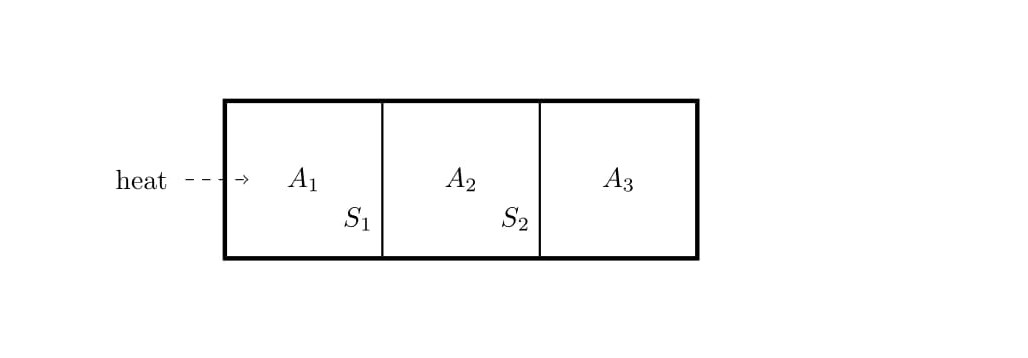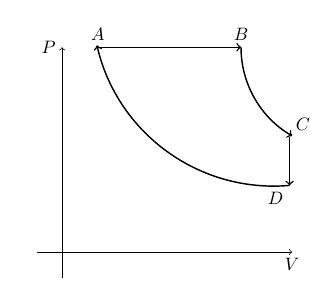|
|
[QUE/TH-13002] TH-PROBLEMNode id: 5187pagea) An ion of mass m and electric charge e is moving in a dilute gas of molecules with which it collides. The mean time between collisions is $\tau$. Let there be a uniform electric field $E$ along the x-axis. Show that the mean distance travelled by the ion is
$$ \frac{Ee}{m}\tau^2$$
assuming the velocity of the ion is zero immediately after collision. |

|
22-01-14 13:01:21 |
n |
|
|
[QUE/TH-09002] TH-PROBLEMNode id: 5186pageThe equation of state of system is given by ( in standard notation).
The internal energy of the system is
$$ P\,=\,\frac{aT^3}{V} $$
$$ U\,=\,BT^n{\ln}(\frac{V}{V_0})\,+\,f(T), $$
where $B\,,n$ and $V_0$ are all constants. $f(T)$ is a function of only $T$.
Find $n$ and a relation between $a$ and $B$. ( Use the fact that entropy is a perfect differential.) |

|
22-01-14 13:01:54 |
n |
|
|
[QUE/TH-08005] TH-PROBLEMNode id: 5185pageThe entropy of water at $100^o$C is $310 \,{\rm{calories/(Kg-Kelvin)}}$ and that of steam at the same temperature is $1760\, {\rm{calories/(Kg-Kelvin)}}$.
(a) What is the latent heat of vaporization at this temperature? Express your answer in calories/Kg.
(b) The enthalpy $H\,=\,U\,+\,PV$ of steam under these conditions is $64\times10^4 {\rm{calories/Kg}}$. Calculate the enthalpy of water in calories/Kg under the same conditions.
(c) Calculate the Gibbs free energy $G\,=\,U\,-\,TS\,+\,PV$
in calories/Kg. |

|
22-01-14 13:01:29 |
n |
|
|
[QUE/TH-08004] TH-PROBLEMNode id: 5184pageConsider a system consisting of $N_1$ atoms of Neon gas, of mass $m_1$ and $N_2$ atoms of Argon gas of mass $m_2$ are in a box a volume $V$. The system is in thermal equilibrium at temperature $T$. Treating them as ideal gas, find the entropy $S$ and the Gibbs free energy $G$ of the system.[ Assume the arbitrary solution of Gibb for the resoultion of the Gibbs paradox]. Answer to be in terms of $N_1\,,\,N_2\,,\,m_1\,,\,m_2\,,\,T$ and the fundamental concepts $h$ and $k$ |

|
22-01-14 13:01:59 |
n |
|
|
[QUE/TH-08003] TH-PROBLEMNode id: 5183page
$$pV\,=\,A(T)\,+\,B(T)p\,+\,C(T)p^2 $$
Find $C_p(T,p)$ in terms of $C_p(T,p_0)$ and $p\,,\,p_0$ ( initial and the final pressures) and $A(T)\,,\,B(T)\,,\,C(T)$ and their derivatives with respect to temperature $T$. [ Write an appropriate expression for
$$\frac{\partial C_p}{\partial p} $$ and use it to obtain $C_p$]
|

|
22-01-14 13:01:49 |
n |
|
|
[QUE/TH-07003] TH-PROBLEMNode id: 5182pageShow that the internal energy of a material whose equation of state is
$$ P\,=\,f(V) T $$
is independent of the volume. ( $P$ and $T$ are the pressure and the temperature of the material) |

|
22-01-14 13:01:14 |
n |
|
|
[QUE/TH-02001] TH-PROBLEMNode id: 5040pageConsider a closed cylinder whose walls are adiabatic. The cylinder is divided into three equal parts $A_1$, $A_2$ and $A_3$ by means of partitions $S_1$ and $S_2$, which can move along the length of the cylinder without friction. The partition $S_1$ is adiabatic and $S_2$ is conducting. Initially, each of the three parts contain one mole of Helium gas, which can be treated as an ideal gas, is at pressure $P_0$, temperature $T_0$ and volume $V_0$. Assume the specific heat at constant volume $C_v\,=\,\frac{3R}{2}$ and the specific heat at constant pressure $C_p\,=\,\frac{5R}{2}$. Now, heat is supplied to the to the left most partition $A_1$ till the temperature in part $A_3$ becomes $T_3\,=\,\frac{9T_0}{4}$ Find the final volume, pressure and temperature in terms of $V_0$, $P_0$ and $T_0$. Assume the entire process is quasistatic.
\vskip 3mm
3. ( Continuation of problem 2)
(a) What is work done by the gas in $A_1$ ?
(b) What is the heat supplied to the gas in $A_1$?
 |

|
22-01-14 10:01:44 |
n |
|
|
[QUE/TH-05003] TH-PROBLEMNode id: 5158pageConsider $n$ mole of ideal gas whose entropy is given by $$ \frac{n}{2}\left[c_1\,+\,5R{\ln}\frac{U}{n}\,+\,2R{\ln}\frac{V}{n} \right]$$ where $R$ is the univeral gas constant, $U$ the internal energy, $V$ the volume and $c_1$ a constant.
- Calculate the specific heats $c_V$ and $c_p$
- A room is at a temperature $273^o$ K which is in equilbrium with the surroundings. One hour after turning on a heater, the room is at $300^o$ K. Assuming the air is described by the equation given above, find the energy density for the two different temperatures. Answer should be in terms of the atmospheric pressure $P_0$, assume it is constant and the room is always at $P_0$.
|

|
22-01-14 10:01:59 |
n |
|
|
[QUE/SM-06001] SM-PROBLEMNode id: 3217page{Consider an open system of non-interacting particles obeying Maxwell-Boltzmann statistics. The system is at temperature $T$ and chemical potential $\mu$. Let $\sigma^2_N$ denote the variance of the number of particles in the system. Show that \begin{eqnarray*} \sigma^2_N &=& k_BT\left( \frac{\partial\langle N\rangle}{\partial\mu}\right)_{T,V}, \end{eqnarray*} where $\langle N\rangle$ is the mean number of particles. The angular brackets denote averaging is carried out over a grand canonical ensemble
KPN |

|
22-01-14 10:01:50 |
n |
|
|
[QUE/SM-06004] SM-PROBLEM Node id: 3219pageConsider a cylindrical system of ideal gas with a movable piston as shown . All the wall.\, including the piston are thermally insulating. A weight W is placed on the piston. Treating this system as a closed one, Show that $$ \frac{W}{A}\,=\,\frac{2E}{3V}$$ where A is the area of cross section of the cylinder, E the energy and V the volume of gas. |

|
22-01-14 10:01:41 |
n |
|
|
[QUE/SM-06003] SM-PROBLEM Node id: 3218pageCalculate $Z_V$ for a classical ideal gas and use it to calculate $(\Delta V)^2 \,=\,\overline{V^2}\,-\,\overline{V}^2 $. |

|
22-01-14 10:01:18 |
n |
|
|
[QUE/SM-02006] SM-PROBLEMNode id: 5148pageConsider a 2 dimensional phase space ( $q,p$) with a rectangular region defined by four corners as shown.

If the region ABCD is the phase space region at time time t = 0 , find the region $A'B'C'D'$ at time t given the Hamiltonian is
$$ H\,=\,\frac{p^2}{2m}\,-\, m a q $$
and explicitly verify that the area is constant. Take the coordinates of A,B,C and D as $(q_A,p_A)\,,\,(q_B,p_A)\,,\,(q_B,p_C)$ and $(q_A,p_C)$ respectively |

|
22-01-14 10:01:19 |
n |
|
|
[QUE/SM-02001] SM-PROBLEMNode id: 5054pageConsider a 2 dimensional phase space ( $q,p$) with a rectangular region defined by four corners as shown.
If the region ABCD is the phase space region at time time t = 0 , find the region $A'B'C'D'$ at time t given the Hamiltonian is
$$ H\,=\,\frac{p^2}{2m}\,-\, m a q $$
and explicitly verify that the area is constant. Take the coordinates of A,B,C and D as $(q_A,p_A)\,,\,(q_B,p_A)\,,\,(q_B,p_C)$ and $(q_A,p_C)$ respectively |

|
22-01-14 10:01:53 |
n |
|
|
[QUE/TH-06008] TH-PROBLEMNode id: 5181pageA Carnot engine is made to operate as a refrigerator, operating at $0^o$ C and discharging heat at $20^o$C. Find the minimum amount of work done by the refrigerator in converting one kilogram of water at $0^o$ into ice. ( Assume latent heat to be $L\,=\, 3.35\times 10^5J/Kg.$) |

|
22-01-14 10:01:51 |
n |
|
|
[QUE/TH-06006] TH-PROBLEMNode id: 5179pageConsider a paramagnetic system, with variables magnetization $M$, the magnetic field $B$ and absolute temperature $T$. ( We assume it's dependence on pressure as negligible). The equation of state is ( which will be obtained from statistical mechanics later in the course) is
$$ M\,=\,C\frac{B}{T}, $$
where $C$ is a constant ( referred to as the Curie constant, who had experimentally obtained this relation.
The system's internal energy is ( for a one-dimensional system)
$$ U\,=\,-MB.$$
The work done on the system by external surrounding is $-MdB$
(a) Write the expression for $DQ$ in terms of $dM$ and $dB$
(b) Write the equation for entropy change $dS$ in terms of $dM$ and $dB$
(c) Obtain the entropy $S$ |

|
22-01-14 09:01:31 |
n |
|
|
[QUE/TH-03003] TH-PROBLEMNode id: 5177pageCalculate the work done when a van der Waals gas of volume $V_1$ expands to a volume $2V_1$ under (a) Constant temperature (b) Under constant pressure. The equation of the gas is
$$ \left(p\,+\,\frac{an^2}{V^2}\right)\left(V\,-\,nb\right)\,=\,nRT $$
where the symbols have the usual meanings. $a$ and $b$ are constants/ |

|
22-01-14 09:01:06 |
n |
|
|
[QUE/SM-01005] SM-PROBLEMNode id: 5149pageUsing the identity $\Gamma(N\,+\,1)\,=\,N!=\,\int_0^\infty x^Ne^{-x} dx $
and write the integral in the form
$$ \int_0^\infty e^{Ng(x)}dx $$
Find the maximum of $g(x)$ ( which occurs say at $x_0$ ). Assume the integral
is dominated by the contribution from the neighbourhood of $x_0$ for large N. Expanding $g(x)$ up to second order in $(x-x_0)$ derive the Stirling's approximation ( for $n\rightarrow\,\infty$)
$$ \rm{ln}N!\,=\,N\rm{ln}N\,-\,N\,+\,\frac{1}{2}\rm{ln}(2\pi N)$$
( More exact formula , just for information, is
$$ N!\,=\,\left(\sqrt{2\pi}\right)e^{-N}N^{N+1/2}\left[1\,+\,\frac{1}{12N}\,+\,\frac{1}{288N^2}\,+\,\ldots\right]$$ |

|
22-01-13 23:01:49 |
n |
|
|
[QUE/TH-06004] TH-PROBLEMNode id: 5163pageCD consists of two adiabatic processes and an isobaric process and an isochoric process of a box of volume V containing perfect gas as shown below

AB is constant volume BC and DA and adiabatic and CD is at constant volume.
Calculate the efficiency of the engine in terms of $V_A$, $V_B$, $V_C$ and the ratio of specific heats $\gamma$.
Remark : The efficency depends upon the equation of state of the system. had we used some other system ( like a gas of photons, whose equation of state, we will discuss soon) the answer is different). Only for carnot's cycle, the efficency is independent of the system.)
|

|
22-01-13 18:01:39 |
n |
|
|
[QUE/TH-01001] TH-PROBLEMNode id: 5151pageShow that constant volume thermometers using an ideal gas as well as a van der Waals gas both yield the same
temperature scale when uniform scales are adopted. Equation of state for ideal gas is \(P V = nRT\) and for van der
Wall gas is
\begin{equation*}
\Big(p + \frac{an^2}{V^2}\Big )(V − nb) = nRT
\end{equation*} |

|
22-01-13 18:01:52 |
n |
|
|
[QUE/TH-01002] TH-PROBLEMNode id: 5152pageA bimetallic strip of total thickness $x$ is straight at temperature $T$. What is the radius of curvature of the strip,
$R$, when it is heated to temperature $T + ∆T$ ? The coefficients of linear expansion of the two metals are $α_1$ and $α_2$ ,
respectively, with \(α_1 > α_2 \). Assume each metal has thickness \(x/2\), and that \(x << R.\) |

|
22-01-13 18:01:05 |
n |